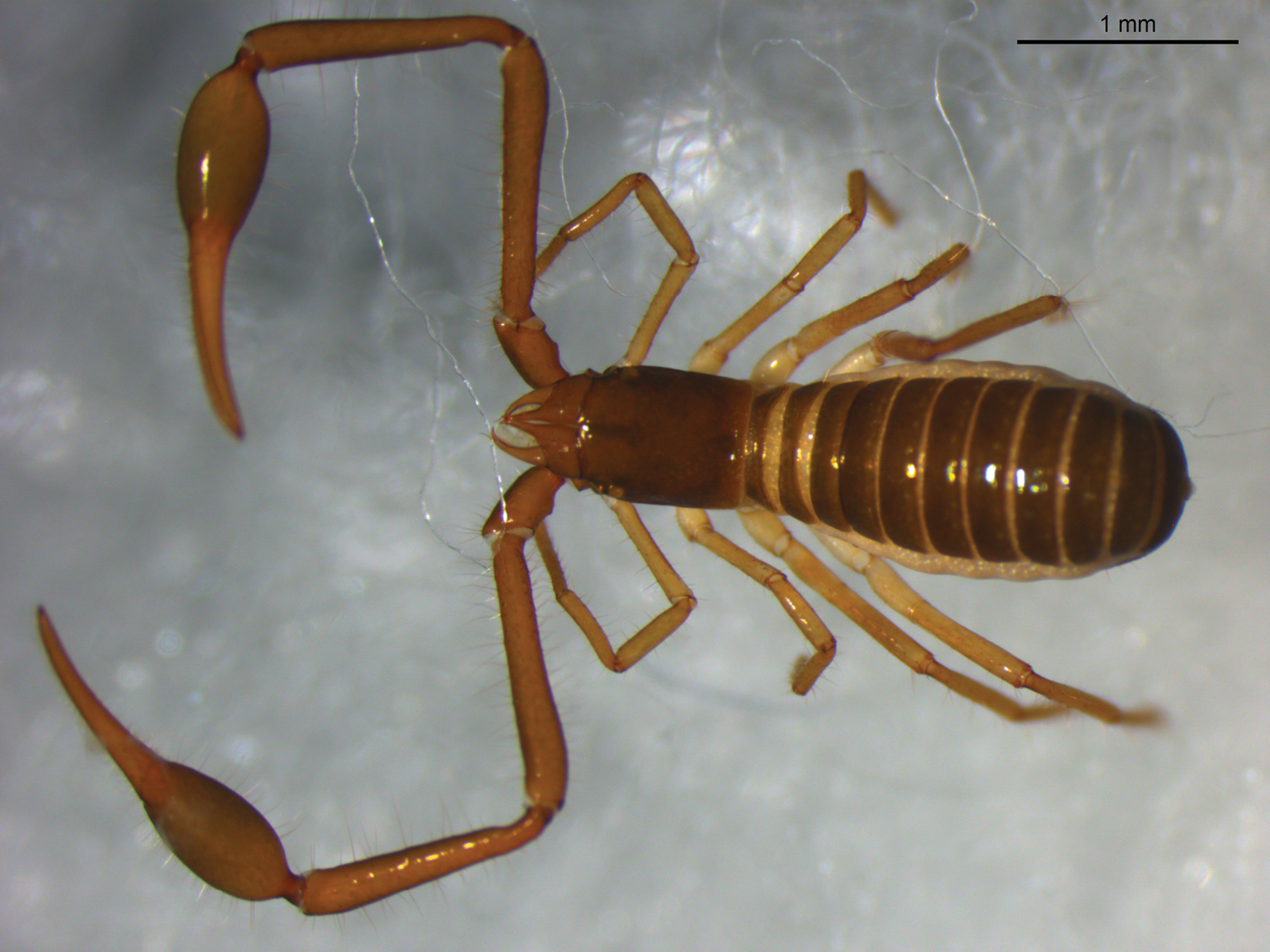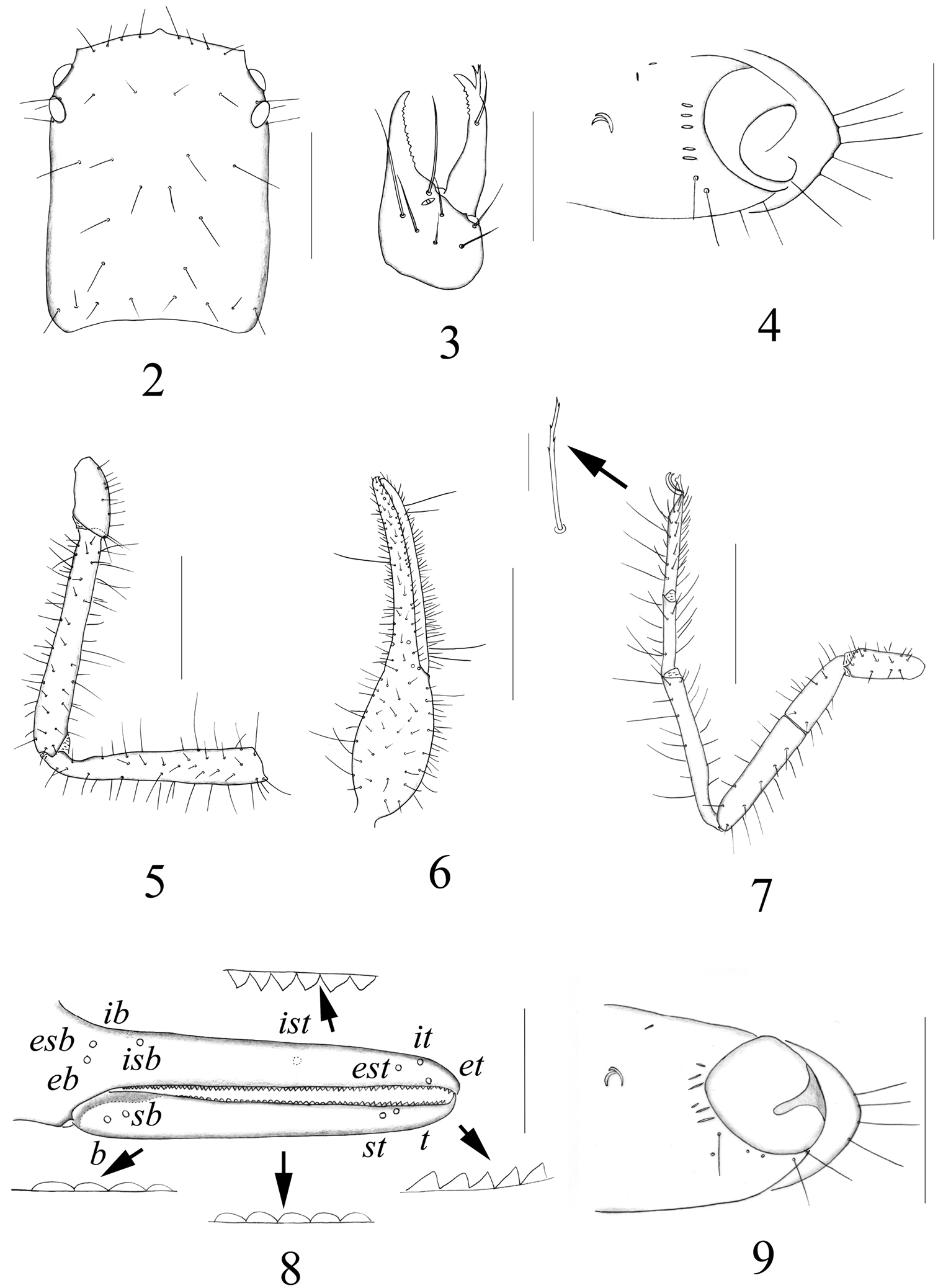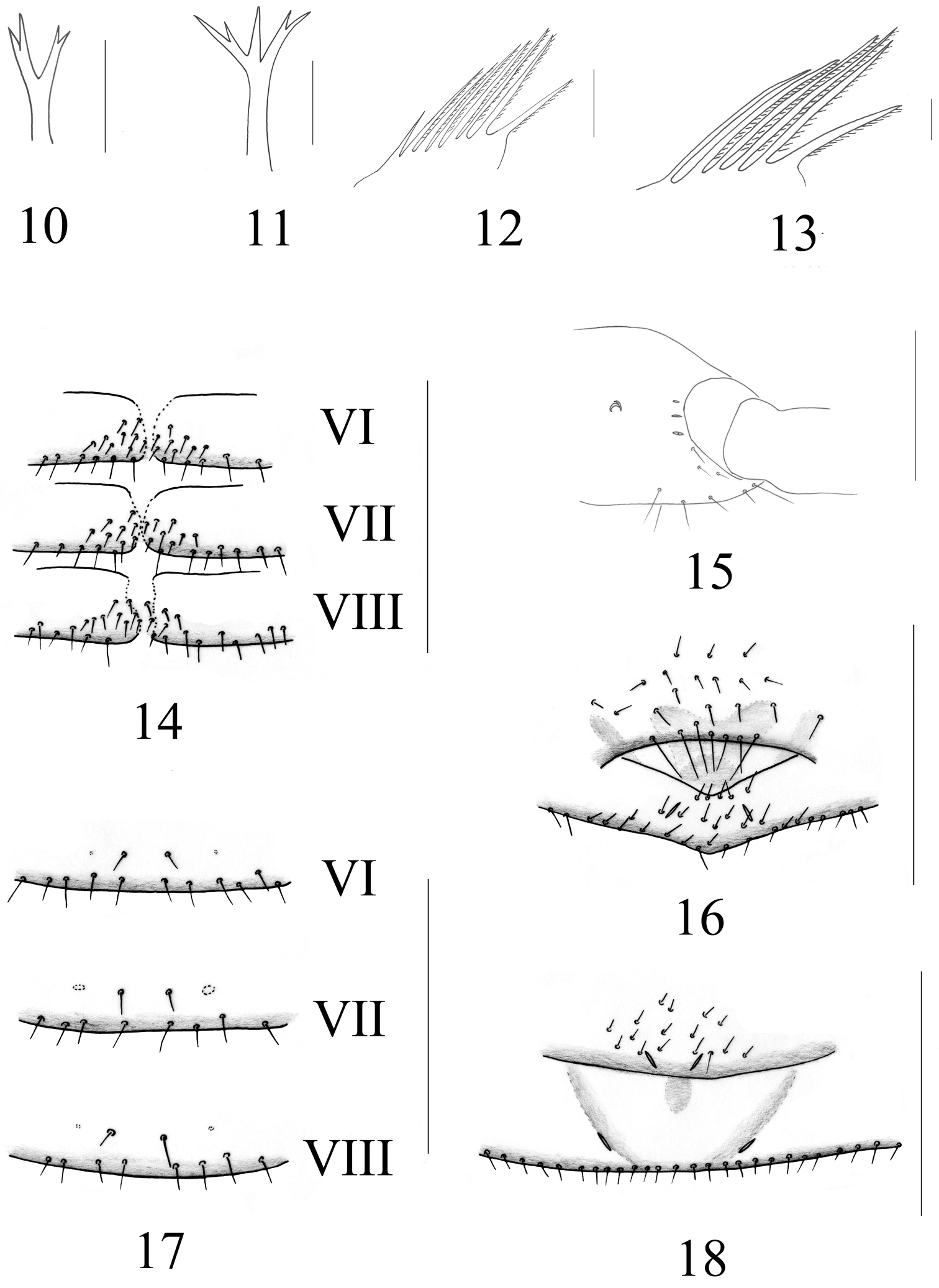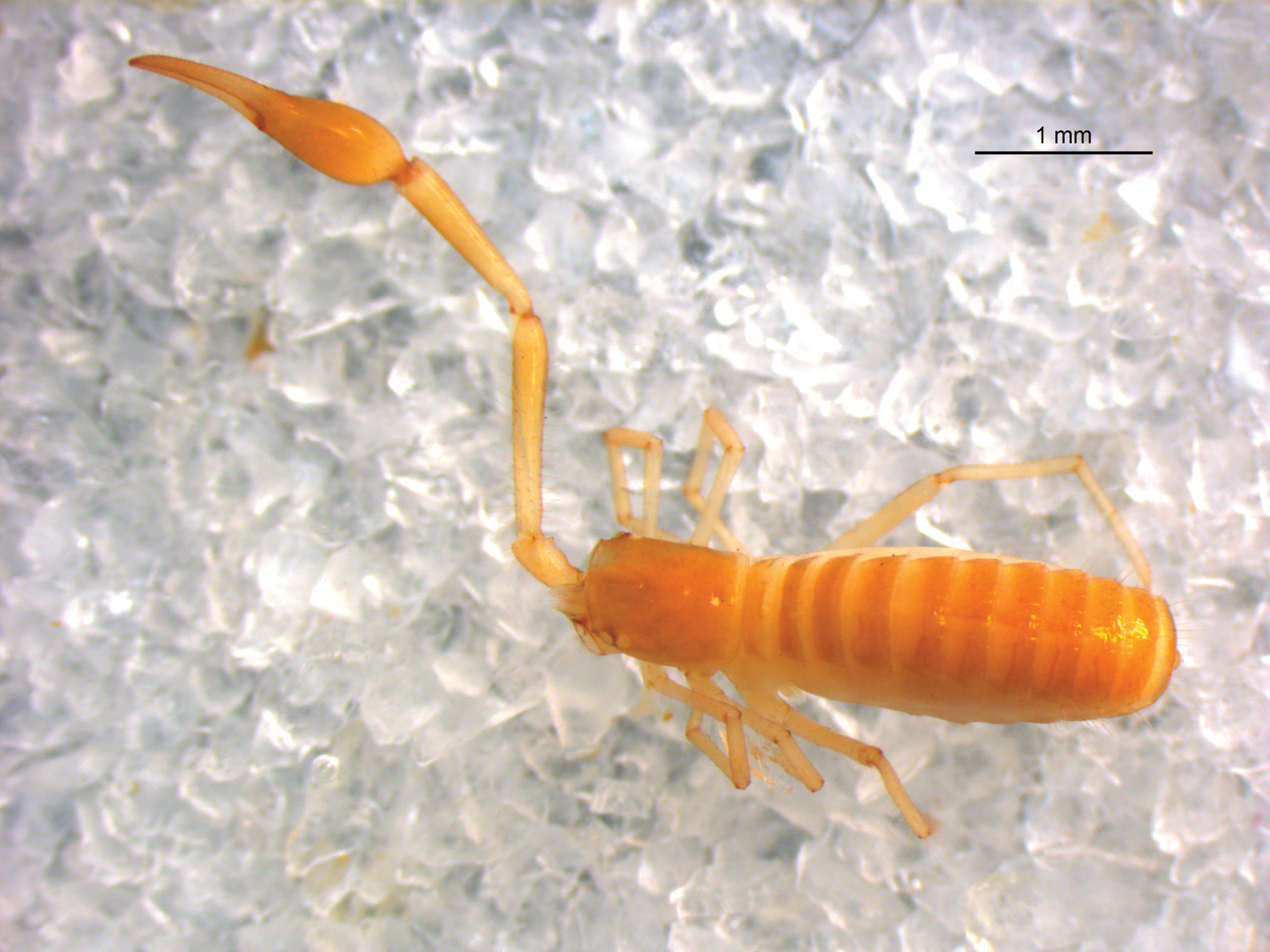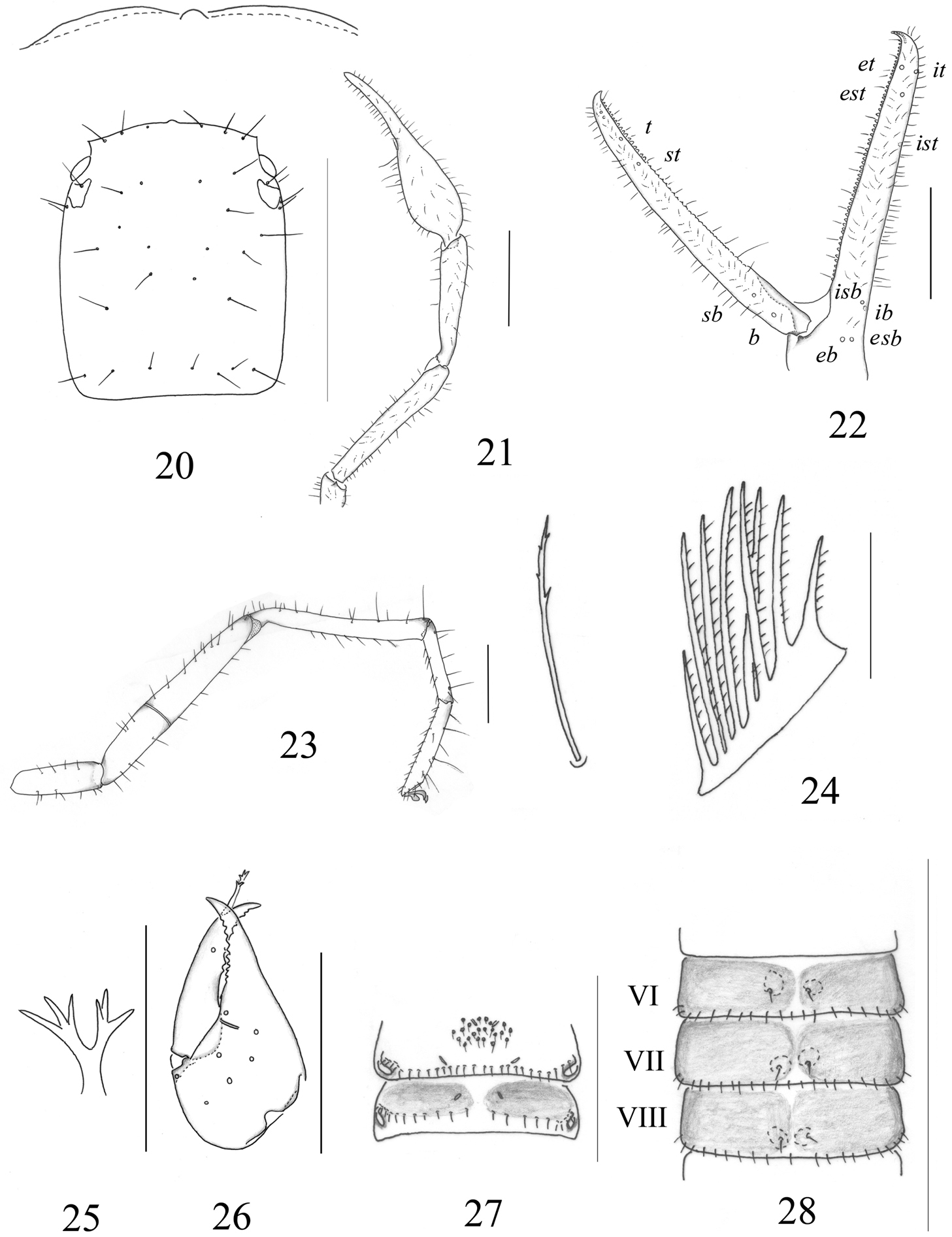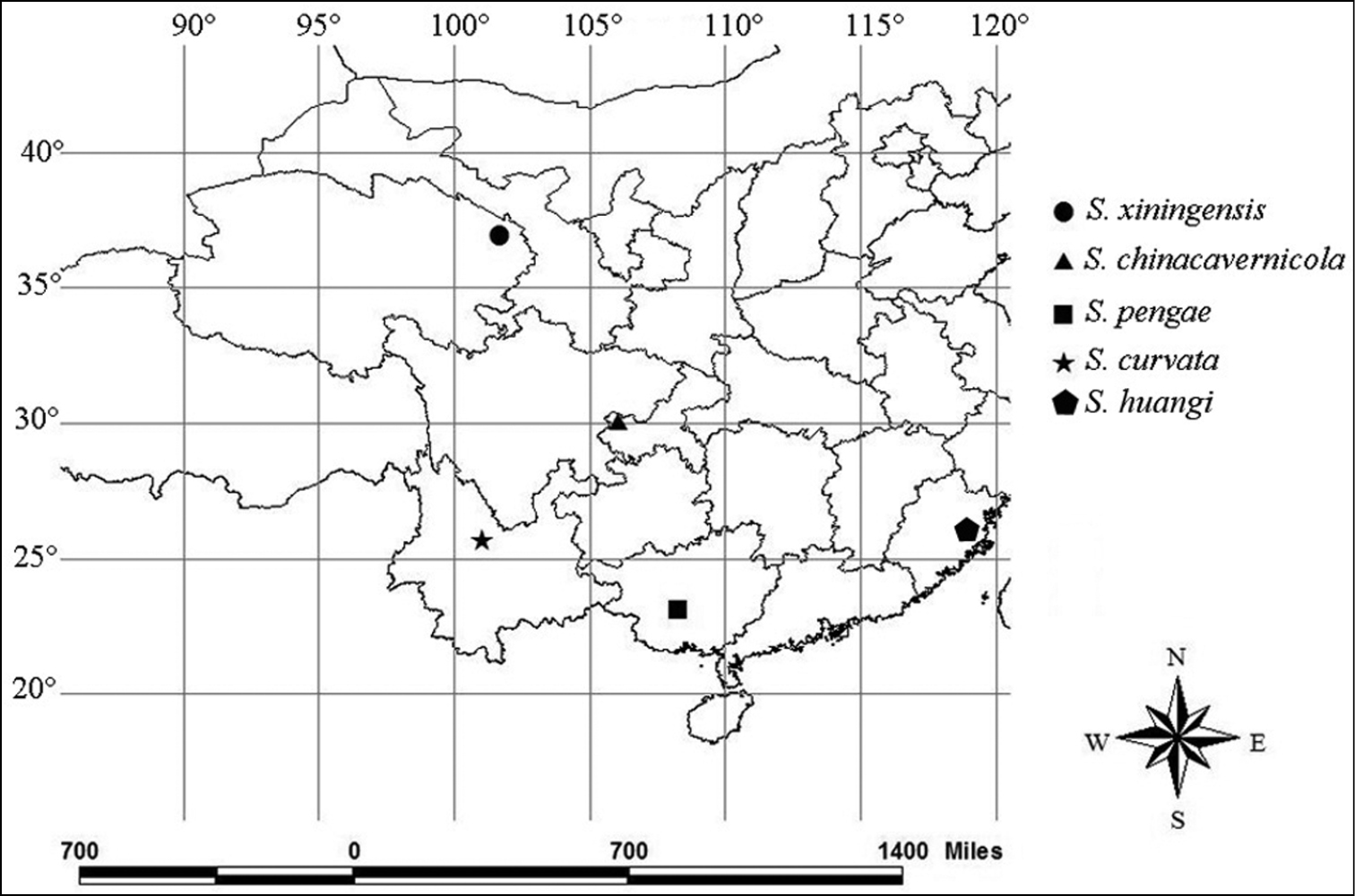






(C) 2012 Jun-Fang Hu. This is an open access article distributed under the terms of the Creative Commons Attribution License 3.0 (CC-BY), which permits unrestricted use, distribution, and reproduction in any medium, provided the original author and source are credited.
For reference, use of the paginated PDF or printed version of this article is recommended.
Two new species of the genus Stenohya Beier, 1967 are described from China: Stenohya pengaesp. n. (male and female; type locality Daming Mountain, Nanning City, Guangxi Zhuang Autonomous Region) and Stenohya huangi sp. n. (female; type locality Gushan Mountain, Fuzhou City, Fujian Prov.).The presence of Stenohya pengae sp. n. in the tree crown of Castanopsis fabri represents a new habitat for Neobisiidae. A key and a distribution map of the Chinese Stenohya species are also provided.
Pseudoscorpions, Neobisiidae, Stenohya, new species, China
Stenohya Beier, 1967 is a small Asian pseudoscorpion genus of the family Neobisiidae Chamberlin, 1930. At present it includes 12 species (
Damingshan National Nature Reserve is located in the midwest of Guangxi Zhuang Autonomous Region, lying on the Tropic of Cancer, and possesses a rich subtropical primeval forest, which is home to many rare animals and plants. Daming Mountains are densely covered by jungle, including trees of the families Fagaceae, Styracaceae, Daphniphyllaceae, Lauraceae and Ericaceae (
The specimens are preserved in 75% alcohol and deposited in the Museum of Hebei University (MHBU). Permanent slide mounts were prepared by removing the chelicerae, pedipalps, leg I and leg IV from specimens with small needles and clearing overnight with lactic acid at room temperature. Drawings were made with the aid of a camera lucida mounted above the eyepiece of a compound microscope. Photographs were taken with a Leica M165 stereomicroscope. Terminology of trichobothria follows
| 1 | Cave-living species, with single pair of eyes reduced to spots | Stenohya chinacavernicola Schawaller, 1995 |
| – | Free-living species, with two pairs of eyes, anterior pair with lens and posterior pair represented by eyespots or weak lenses | 2 |
| 2 | Trichobothria it and et at same level | Stenohya huangi sp. n. |
| – | Trichobothrium it posterior to et, situated midway between est and et | 3 |
| 3 | Male with slender pedipalps (femur 6.79–7.20, patella 6.17–6.25 times longer than broad) | Stenohya pengae sp. n. |
| – | Male with less slender pedipalps (femur 5.00–6.42, patella 3.29–4.68 times longer than broad) | 4 |
| 4 | Movable chelal finger with more than 70 contiguous teeth; male sternites V–X with a pair of medial discal setae; male chela with movable chelal finger straight, hand without a spine | Stenohya xiningensis Zhao et al., 2011 |
| – | Movable chelal finger with less than 50 teeth, which are not contiguous; male sternites VI–VIII with a pair of medial discal setae; male chela with movable chelal finger curving in basal third in ventral view, hand with a spine | Stenohya curvata Zhao et al., 2011 |
urn:lsid:zoobank.org:act:3E8D205C-B127-4BE0-AC87-B029B7F9719F
http://species-id.net/wiki/Stenohya_pengae
Figs 1–8, 10–18Holotype male (Ps.-MHBU-GX110521), China: Guangxi Province, Nanning City, Daming Mountain [23°08'N, 108°17'E], alt. 1250 m, 21 May 2011, Yan-qiu Peng leg. Tree-crown layer of Castanopsis fabri. Paratypes: 17 males and 25 females, same data as for holotype.
The specific name is a patronym in honour of Ms Yan-qiu Peng, who collected the specimens.
Movable cheliceral finger with one seta; movable chelal finger with 45–47 teeth; male pedipalpal chela 4.58–4.64 (female 4.09–4.25) times longer than broad; trichobothrium it halfway between est and et.
(Fig. 1). Colour mostly dark brown, pedipalps and legs reddish brown. Setae of body straight and acicular.
Stenohya pengae sp. n., dorsal view of male holotype.
Carapace (Fig. 2) smooth, longer than broad, with a total of 34–36 setae, including 8 on anterior margin and 8 on posterior margin; paired lyrifissures near the eyes and posterior margin; epistome small and triangular; 4 eyes, anterior pair with well developed lens, posterior pair with weak lens.
Stenohya pengae sp. n., male holotype (2–7) and Stenohya xiningensis Zhao et al., 2011, male (9) 2 Carapace, dorsal view 3 Right chelicera 4 Coxa of right pedipalp, lateral view, showing lyrifissures 5 Pedipalp (minus chela), dorsal view 6 Chela, dorsal view 7 Leg IV 8 Fingers of right chela, lateral view, showing trichobothriotaxy and teeth; Stenohya xiningensis 9 Coxa of right pedipalp, lateral view, showing lyrifissures. Scale bars: 1 mm (5–7); 0.5 mm (2, 4, 8–9); 0.4 mm (3).
Abdomen. Pleural membrane granulate. Tergal chaetotaxy: 6: 8: 8–10: 10–12: 10–11: 11–12: 11–12: 10–11: 10–11: 9–11: 6–8: 2, including at least 4 tactile setae on tergites V–XI. Anterior genital operculum (Fig. 16) with 23–24 setae; posterior genital sternite with 12–14 scattered setae and 2 lyrifissures;. chaetotaxy of remaining sternites (IV–XI) 20–22: 22–24: 22–24: 20–24: 18–20: 19–22: 15–18: 8–10: 2, sternites VI–VIII (Fig. 14) with 13–15 medial discal setae.
Stenohys pengae sp. n. 10 Galea, male 11 Galea, female 12 Rallum, female 13 Rallum, male 14 Male sternites VI–VIII, with 13–15 medial discal setae 15 Coxa of right pedipalp, female, lateral view, showing lyrifissures 16 Genital sternites, male 17 Female sternites VI–VIII with 2 medial discal setae 18 Genital sternites, female. Scale bars: 1 mm (14–15); 0.5 mm (16–18); 0.05 mm (10–13).
Pedipalps (Fig. 4) smooth; apex of coxa rounded and with 5 setae; lateral face of coxa with 3–5 ordinary lyrifissures near margin of foramen, plus 1–3 dorsally and 2 curved posterior maxillary lyrifissures. Venom apparatus present only in fixed chelal finger, venom duct very short. Femur straight; patella claviform and internal face with a tubercle at base. Trichobothrial pattern (Fig. 8): eb and esb situated near base of finger, grouped very closely with ib and isb; est, et and it grouped together near finger tip; ist nearer to it than to isb; b and sb situated closer to each other in basal half, st and t close to each other in distal half of movable finger. Fixed chelal finger with 70–74 pointed teeth of unequal length, movable finger with about 45–47 teeth, which are pointed and of slightly unequal length in distal part, rounded in middle part and low in basal part, all teeth contiguous.
Chelicera (Fig. 3). Palm with 7 setae (only one male with 7 on left and 8 on right cheliceral palm), movable finger with 1 sub-medial seta; fixed finger with 13–14 teeth; movable finger with 6–7 teeth; serrula exterior with 40–43 lamellae; serrula interior with 30–32 lamellae; galea (Fig. 10) elongated and divided into two main branches, each branch secondarily divided into 2 terminal branchlets; rallum (Fig. 13) of 6 blades, all blades with anteriorly-directed spinules except the basal-most blade, distalmost blade somewhat widened at its base and distinctly shorter than second blade.
Leg IV (Fig. 7). Tibia with 4 tactile setae (TS 0.14–0.26, 0.30–0.48, 0.62–0.74 and 0.86–0.96), basitarsus with 4 tactile setae (TS 0.13–0.15, 0.25–0.42, 0.62–0.67 and 0.84–0.87), telotarsus with 3 tactile setae (TS 0.10–0.14, 0.27–0.36 and 0.51–0.63). Subterminal setae bifurcate, dorsal branch also terminally bifurcate; arolium not divided, shorter than claws, which are slender and simple.
Dimensions (in mm) and ratios (in parentheses).Body length 3.3–3.6. Carapace 1.05–1.10/0.82–0.85 (1.28–1.29); diameter of anterior eye 0.10–0.11; diameter of posterior eye 0.10–0.12. Pedipalps: trochanter 0.60–0.70/0.25–0.32 (2.19–2.40), femur 1.80–1.90/0.25–0.28 (6.79–7.20), patella 1.75–1.85/0.28–0.30 (6.17–6.25), chela (with pedicel) 2.38–2.55/0.52–0.55 (4.58–4.64), chela (without pedicel) 2.18–2.40 (4.19–4.36), hand length (without pedicel) 0.95–1.05 (1.83–1.91), movable finger length 1.35–1.40 (1.33–1.42 times longer than hand without pedicel). Chelicera 0.55–0.60/0.30–0.32 (1.83–1.88), movable finger length 0.35–0.44. Leg I: femur 0.85–0.87/0.14–0.18 (4.83–6.07), patella 0.55–0.58/0.13–0.15 (3.87–4.23), tibia 0.60–0.65/0.10–0.11 (5.91–6.00), basitarsus 0.45–0.48/0.09–0.10 (4.80–5.00), telotarsus 0.50–0.52/0.09–0.10 (5.20–5.56). Leg IV: femur + patella 1.45–1.55/0.22–0.24 (6.46–6.59), tibia 1.10–1.15/0.13–0.15 (7.67–8.46), basitarsus 0.55–0.58/0.08–0.10 (5.80–6.88), telotarsus 0.65–0.70/0.08–0.10 (7.00–8.13).
Like male, except as follows. Carapace with a total of 30–34 setae, including 6 setae on anterior margin and 6–8 setae on posterior margin. Tergal chaetotaxy: 6–10: 8–10: 9–10: 10–12: 11–12: 10–12: 11–13: 12–15: 11–13: 11–13: 6–8: 2, including at least 4 tactile setae on tergites IV–XI. Anterior genital sternite (Fig. 18) with 16–18 small marginal setae and 2 lyrifissures; posterior genital sternite with 28–32 marginal setae and 2 lyrifissures; chaetotaxy of remaining sternites (IV–XI) 24–30: 23–27: 22–26: 19–22: 20–21: 17–20: 15–19: 7–8: 2, sternites VI–VIII (Fig. 17) with a pair of medial discal setae, clearly longer than marginal setae.
Pedipalps. Lateral face of coxa with 3–5 ordinary lyrifissures at margin of foramen, plus 0–3 at dorsal margin and 2 curved lyrifissures; fixed chelal finger with 66–79 teeth, movable finger with about 45–55 contiguous teeth which are pointed and of slightly unequal length in distal half, rounded and low in basal half.
Chelicera. Palm with 7 setae (two females with 8 on left and 7 on right cheliceral palm, one female with 6 on left and 7 on right palm), movable finger with 1 sub-medial seta; serrula exterior with 34–36 lamellae; serrula interior with 28–33 lamellae; galea (Fig. 11) elongate and divided into three main branches, two of which are secondarily divided into 2 terminal branchlets; rallum (Fig. 12) of 8 blades.
Dimensions (in mm) and ratios. Body length ca. 3.9–5.0. Carapace 0.95–1.00/0.80–0.85 (1.15–1.28); diameter of anterior eye 0.11–0.13; diameter of posterior eye 0.12–0.14. Pedipalps: trochanter 0.53–0.55/0.25–0.30 (1.83–2.12), femur 1.40–1.45/0.24–0.28 (5.18–5.83), patella 1.10–1.15/0.28–0.30 (3.83–3.93), chela (with pedicel) 2.25–2.33/0.53–0.57 (4.09–4.25), chela (without pedicel) 2.10–2.18 (3.82–3.96), hand length (without pedicel) 0.85–0.95 (1.60–1.67), movable finger length 1.17–1.20 (1.26–1.38 times longer than hand without pedicel). Chelicera 0.70–0.75/0.35–0.40 (1.88–2.00), movable finger length 0.45–0.50. Leg I: femur 0.70–0.80/0.13–0.14 (5.38–5.71), patella 0.45–0.50/0.13–0.14 (3.46–3.57), tibia 0.50–0.55/0.09–0.10 (5.50–5.56), basitarsus 0.35–0.37/0.08–0.09 (4.11–4.38), telotarsus 0.43–0.45/0.09–0.10 (4.50–4.78). Leg IV: femur + patella 1.30–1.40/0.23–0.24 (5.65–5.83), tibia 1.10–1.15/0.13–0.14 (8.21–8.46), basitarsus 0.50–0.55/0.08–0.10 (5.50–6.25), telotarsus 0.60–0.65/0.08–0.10 (6.50–7.50).
This species is known only from the type locality.
Three Stenohya species have been previously recorded from China: Stenohya chinacavernicola Schawaller, 1995, Stenohya curvata Zhao et al., 2011 and Stenohya xiningensis Zhao et al., 2011. Stenohya pengae sp. n. can easily be separated from these species by its extremely slender pedipalpal segments, 4 well-developed eyes, the absence of a spine at the base of the male chelal hand, and the presence of medial discal setae on male sternites VI–VIII only.
The new species resembles Stenohya martensi (Schawaller, 1987) in having slender pedipalps, but it can be distinguished from the latter by the movable cheliceral finger having only one seta (two in Stenohya martensi), the movable chelal finger with 45–47 teeth (more than 80 in Stenohya martensi) and the male pedipalpal chela 4.58–4.64 times longer than broad (6.2 times in Stenohya martensi). Stenohya caelata (Callaini, 1990) and Stenohya kashmirensis (Schawaller, 1988) differ from Stenohya pengae sp. n. in having granules on the pedipalpal femur and patella, and the cheliceral palm with 5 or 6 setae. The new species can be easily distinguished from Stenohya mahnerti Schawaller, 1994, Stenohya hamata (Leclerc and Mahnert, 1988) and Stenohya gruberi (Ćurčić, 1983) by the more slender pedipalpal femur and patella. Stenohya heros (Beier, 1943) has less slender pedipalp in female (femur 4.5 vs. 5.18–5.83 times, patella 3.2 vs. 3.83–3.93, chela (with pedicel) 3.3 vs. 4.09–4.25, movable finger 1.0 vs. 1.26–1.38 times longer than hand without pedicel). Stenohya vietnamensis Beier, 1967 and Stenohya lindbergi (Beier, 1959) were both described from nymphs, but Stenohya vietnamensis lacks an epistome and Stenohya lindbergi has more teeth (78) on the movable chelal finger.
Specimens of Stenohya pengae were found on the leaves of Castanopsis fabri, which represents an exceptional habitat for Neobisiidae. Neobisiidae generally live in leaf litter and soil, under rock, bark and in caves, although they have sometimes been found climbing young trees and shrubs (Weygoldt, 1969). Fourty-one specimens of Stenohya pengae were collected by sweeping trees of Castanopsis fabri with an entomological net; only two were found on stone steps and these might have been dislodged from the trees. The collector also examined the tree bark and leaf litter around the trees, without finding any specimens of Stenohya pengae.
Approximately 100 pseudoscorpion specimens were collected from Fujian and Guangdong provinces were extracted by beating shrubs, of which 74 (including 4 protonymphs, 2 deutonymphs, 11 tritonymphs and 57 adults) belong to the genus Geogarypus Chamberlin, 1930 (family Geogarypidae Chamberlin, 1930) and 22 tritonymphs belong to the genus Bisetocreagris Ćurčić, 1983 (family Neobisiidae). All of the Stenohya pengae specimens were adults.
urn:lsid:zoobank.org:act:AED176C9-840E-4C15-9981-8777D01C6632
http://species-id.net/wiki/Stenohya_huangi
Figs 19–28Holotype female (Ps.-MHBU-FJ750224), China: Fujian Province, Fuzhou City, Gushan Mountain [26°04'N, 119°21'E], 24 February 1975, Fu-sheng Huang. Habitat unknown.
The specific name is a patronym in honour of Prof. Fu-Sheng Huang, who collected and donated the specimen.
Species with slender pedipalps (femur 6.40, patella 5.25, chela with pedicel 4.87, chela without pedicel 4.57 times as long as broad) and slender legs IV (e.g. femur+patella 7.23 times as long as deep), with low numbers of the teeth (about 30) on movable chelal finger; trichobothria it and et at same level.
(Fig. 19). Colour mostly yellow, setae of body straight and acicular.
Stenohya huangi sp. n., dorsal view of female holotype (chelicerae, left palp and left leg IV removed).
Carapace (Fig. 20) smooth, with a total of 36 setae, including 6 on anterior margin and 8 on posterior margin; epistome small and triangular; 4 eyes, anterior pair with lens, posterior pair with weak lenses; lateral margins slightly convex.
Stenohya huangi sp. n., female. 20 Carapace 21 Right pedipalp, dorsal view 22 Fingers of left chela, lateral view 23 Leg IV 24 Rallum 25 Galea 26 Left chelicera 27 Genital sternites 28 sternites VI–VIII, showing paired medial discal setae. Scale bars: 1 mm (20–21, 28); 0.5 mm (22–23, 26–27); 0.05 mm (24–25).
Distribution map of Chinese Stenohya species.
Abdomen. Pleural membrane strongly granulate. Tergal chaetotaxy: 4: 12: 10: 10: 10: 10: 11: 11: 11: 10: 9, including at least 4 tactile setae on tergites VI–XI; anterior genital sternite (Fig. 27) with 22 small marginal setae and 2 lyrifissures; posterior genital sternite with 20 marginal setae and 2 lyrifissures; sternal chaetotaxy (IV–XI): 27: 22: 22: 22: 24: 22: 19: 17:10, sternites VI–VIII (Fig. 28) with a pair of discal setae; anal cone with 2 dorsal and 2 ventral setae.
Pedipalps (Figs 21–22). Apex of coxa rounded and with 4 setae, lateral face of coxa with 2 ordinary lyrifissures at margin of foramen, and 2 curved lyrifissures. Anterior face of femur with fine granulation; patella claviform, smooth; chelal fingers long and slender. Trichobothriotaxy: est, et and it grouped together distally; ist situated midway between isb and it, nearer to it than to isb. eb and esb situated on base of the hand, grouped very closely with ib and isb; b and sb closer to each other situated on the basal half, and st and t closer to each other situated on the distal half of the movable finger. Fixed chelal finger with 63 pointed teeth of unequal length, movable finger with about 30 teeth which with 20 pointed teeth slightly unequal length in distal half, and 10 rounded teeth in basal half.
Cheliceral palm (Fig. 26) with 7 setae, movable finger with 1 sub-medial seta; fixed finger with 12 teeth; movable finger with 6 teeth; serrula exterior with 30 lamellae; serrula interior with 28 lamellae; galea (Fig. 25) elongated and divided into two main branches, each branch secondarily divided into 3 terminal branchlets; rallum of 8 blades (Fig. 24), all blades with anteriorly-directed spinules, the basalmost blade about half of the length of the others, distalmost blade distinctly shorter than second one and somewhat widened at its base.
Legs (Fig. 23). Tibia IV with 2 tactile setae (TS 0.70, 0.95), basitarsus IV with 2 tactile setae (TS 0.15, 0.81), and telotarsus IV with 2 tactile setae (TS 0.27, 0.61). Subterminal tarsal seta bifurcate; arolium not divided, shorter than slender and simple claws.
Dimensions (in mm) and ratios (in parentheses). Body length 4.2. Carapace 1.29/0.89 (1.45); diameter of anterior eye 0.10; diameter of posterior eye 0.09. Pedipalps: trochanter 0.59/0.26 (2.27), femur 1.58/0.25 (6.32), patella 1.38/0.26 (5.31), chela (with pedicel) 2.58/0.53 (4.87), chela (without pedicel) 2.42 (4.57), hand length (without pedicel) 1.04 (1.96), movable finger length 1.44 (1.38 times longer than hand without pedicel). Chelicera 0.67/0.38 (1.76), movable finger length 0.45. Leg I: femur 0.79/0.13 (6.08), patella 0.59/0.13 (4.54), tibia 0.63/0.10 (6.30), basitarsus 0.45/0.10 (4.50), telotarsus 0.43/0.10 (4.30). Leg IV: femur + patella 1.52/0.21 (7.24), tibia 1.22/0.12 (10.17), basitarsus 0.59/0.10 (5.90), telotarsus 0.79/0.10 (7.90).
This species is known only from the type locality.
Stenohya huangi sp. n. is only known from the female, but it can be easily separated from most other species of this genus by the proportions of pedipalpal femur and patella (Table 1). Two species, Stenohya xiningensis Zhao et al., 2011 and Stenohya kashmirensis, are only known from males, while two others, Stenohya lindbergi and Stenohya vietnamensis are only known from nymphs. Stenohya huangi differs from Stenohya xiningensis by the arrangement of trichobothria on the fixed chelal finger: it and et are at the same level (Fig. 22) in Stenohya huangi, whereas in Stenohya xiningensis it lies about midway between est and et (
Proportions of femur and patella of pedipalps in females of Stenohya.
| Species | Femur | Patella |
|---|---|---|
| Stenohya caelata | 4.50–4.64 | 3.63–3.64 |
| Stenohya chinacavernicola | 5.70 | 4.75 |
| Stenohya curvata | 5.00–5.24 | 3.29–3.33 |
| Stenohya gruberi | 4.77 | 3.30 |
| Stenohya hamata | 4.46–4.51 | 3.32–3.46 |
| Stenohya heros | 4.50 | 3.20 |
| Stenohya huangi | 6.32 | 5.31 |
| Stenohya mahnerti | 4.60 | 3.00 |
| Stenohya martensi | 5.00 | 3.90 |
| Stenohya pengae | 5.18–5.83 | 3.83–3.93 |
In most Neobisiidae the lyrifissures near the trochanteral foramen of the pedipalpal coxa number 3 or 4 (
Many thanks are given to Dr Volker Mahnert (Muséum d'Histoire naturelle, Geneva), Dr Mark S. Harvey (Western Australian Museum, Perth, Australia) and an anonymous referee for helpful comments on different versions of the manuscript. Help with literature was provided by Dr Mark L.I. Judson (Muséum national d'Histoire naturelle, Paris). This work was supported by the National Natural Science Foundation of China (Nos. 31093430, 31071885, 30970325).
